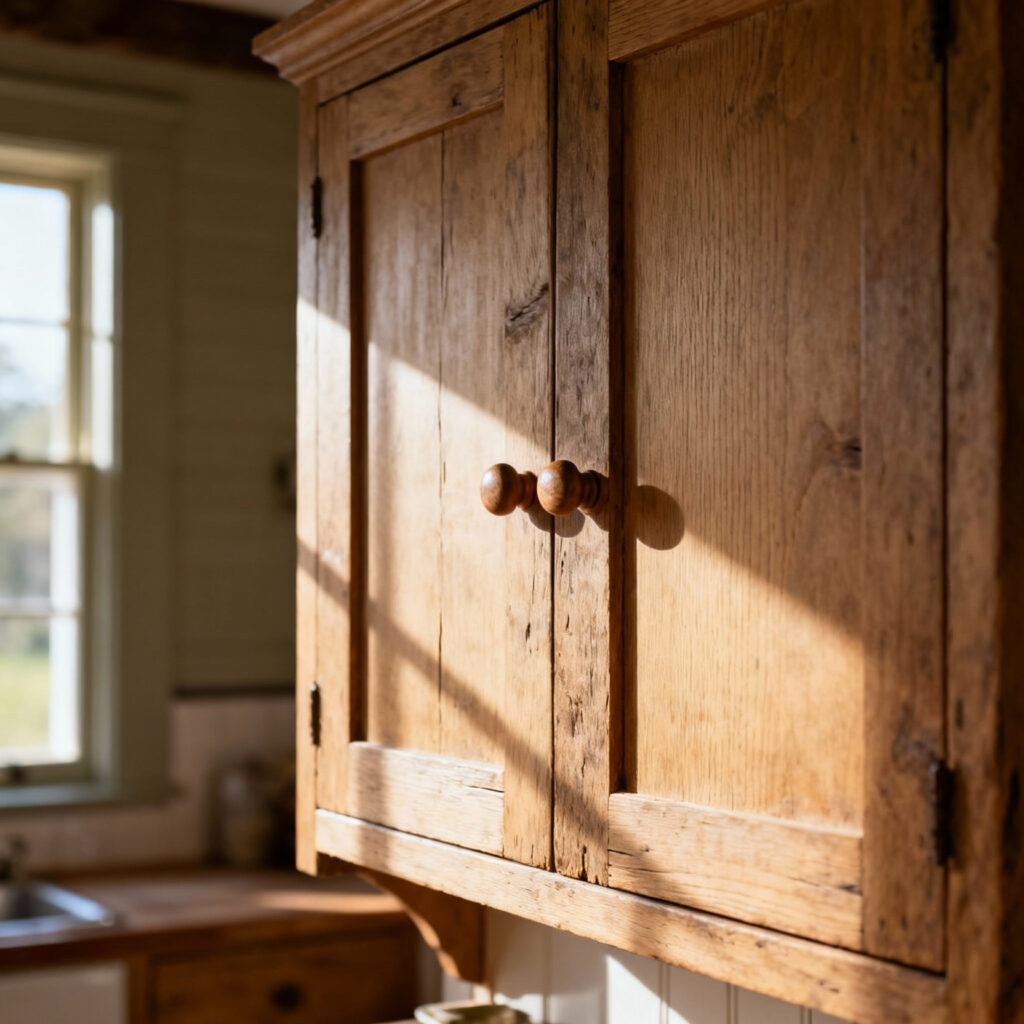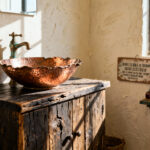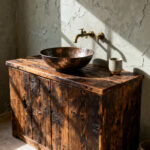Since agrarian life first took root, the farmhouse kitchen has been the absolute heart of the home, its cabinetry evolving from simple, handmade fixtures into a refined expression of life and work. Today’s most sophisticated farmhouse kitchens understand this heritage—it’s a dance between profound history and the demands of modern life. What I’ve learned from years of period-appropriate renovation is that the principles separating enduring, authentic farmhouse kitchens cabinets from short-lived trends haven’t changed in generations.
Authentic design isn’t about slapping on some shiplap or a distressed finish; that’s just imitation. The real thing is born from a deep respect for honest materials, pragmatic function, and the hand of the craftsman. It’s a philosophy where every line and joint serves a purpose, creating cabinetry that earns a rich patina over decades, telling the story of a home. This guide will walk you through the 20 principles that matter, moving from the foundational history to the materials, the spatial layout, and finally, how these choices shape a way of life. This isn’t just about aesthetics; it’s about becoming a steward of your home’s architectural soul.
Foundational Principles: Unearthing the Vernacular Pedigree (Part 1)
To get this right, you first have to understand where these cabinets came from—not from a catalogue, but from the land and the lives of the people who built them. This is about digging into the historical DNA of farmhouse design, which is the only way to create something that feels truly authentic and timeless.
1. Deconstructing the Vernacular Genesis: Tracing the Evolution of Farmhouse Cabinet Forms
Farmhouse cabinetry wasn’t dreamed up in a design studio. It was born from necessity, evolving slowly from the unpretentious, locally-sourced traditions of rural life. The first farmhouse kitchens didn’t even have built-in cabinets; they relied on freestanding furniture. Think unfitted larders, simple pie safes, and sturdy worktables, all built from whatever timber was available nearby, often by the homeowners themselves. The focus was one hundred percent on durability and function, not ornamentation.
The move to built-in cabinets happened gradually, driven by a better understanding of hygiene and a need for more efficient storage as homes became more permanent. This is where you see the emergence of strong, framed construction that could take a beating. Shaker cabinetry, with its clean lines and utter lack of adornment, is the direct descendant of this mindset—an almost spiritual devotion to honest work. Seeing this evolution from detached furniture to integrated, practical cabinetry is key. In my historic home renovation specialist practice, I stress that understanding this vernacular past is non-negotiable for anyone who wants to replicate that authentic feeling today.
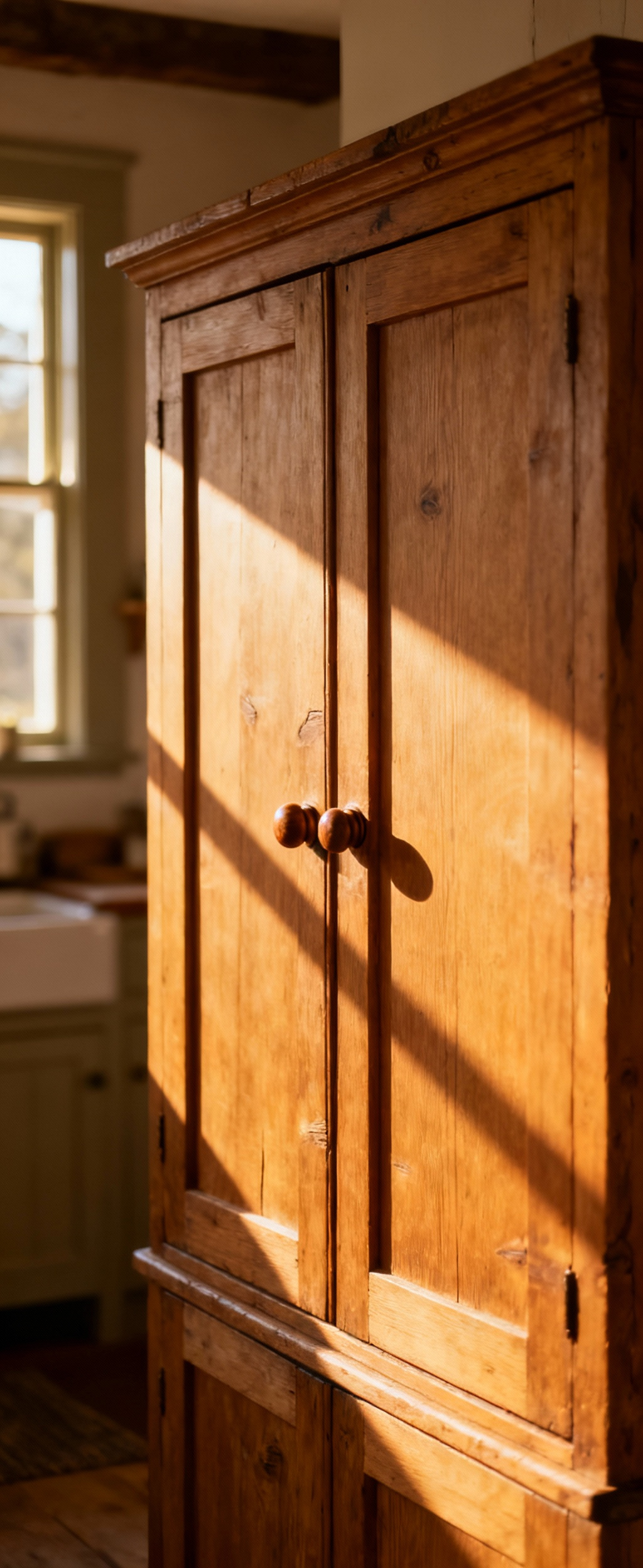
2. Embracing Functional Pragmatism: Prioritizing Utility as the Quintessential Aesthetic Tenet
Flowing directly from that history is the most important rule of all: in a real farmhouse kitchen, function is the aesthetic. It’s not just one part of the design; it is the design. Every choice, from the joinery to the layout, has to serve a practical purpose first. Beauty here comes from utility done exceptionally well.
This philosophy shows up in very specific ways: deep drawers built to hold a harvest’s worth of supplies, open shelves for quick access to daily plates, and countertops that are unapologetically built for work. Materials are chosen for how well they stand up to wear and tear, not for their flashiness. Solid wood, often from local mills, was the obvious choice for its strength and ability to age gracefully. Even the finishes were simple—milk paint, oil, or just left natural. The goal was to protect the wood, not hide it behind a delicate, easily damaged surface. This honesty about purpose is what gives true farmhouse kitchens cabinets their quiet elegance.
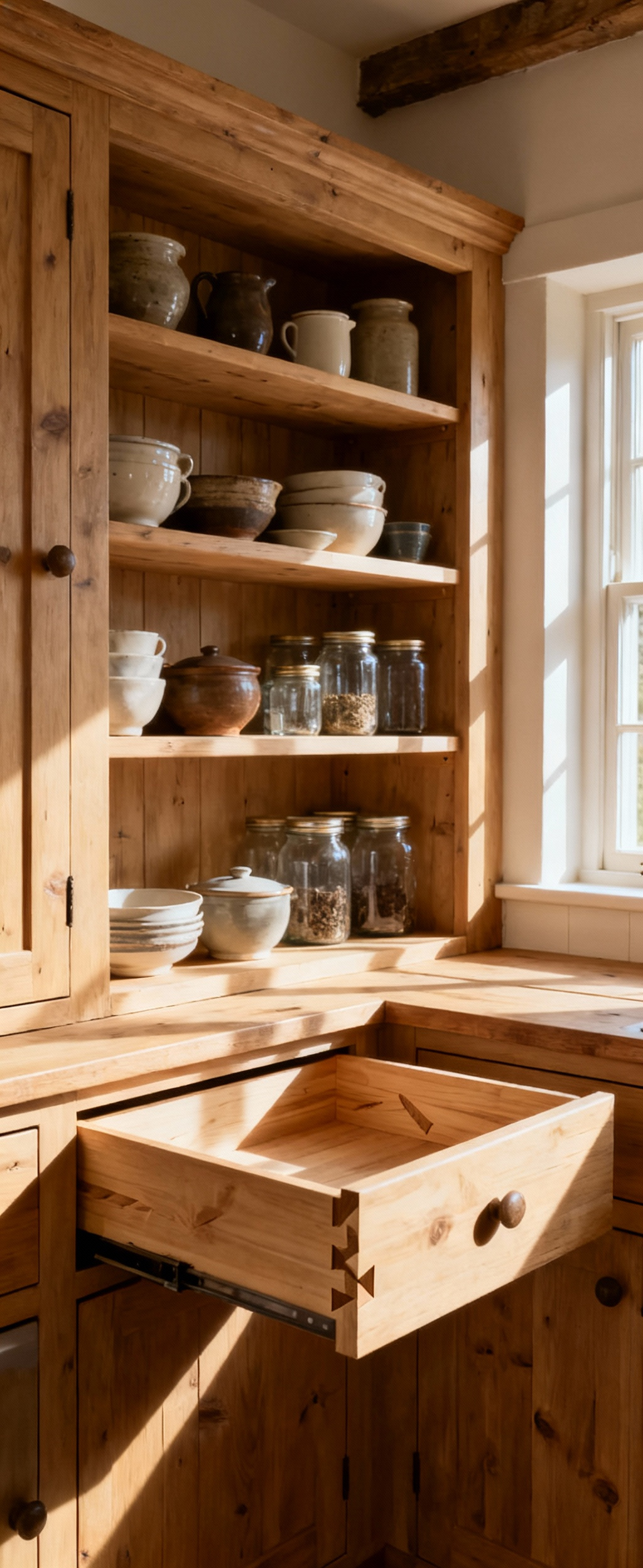
3. Cultivating Heirloom Character: Strategically Integrating Patina and Deliberate Imperfection
When function is your guide, you naturally start to value heirloom character. This isn’t about faking an aged look; it’s about building something that is meant to age, to absorb the story of the house. True authenticity embraces the passage of time and the marks it leaves behind. It’s about welcoming patina and even some deliberate imperfection.
Patina—that soft sheen and subtle color change that comes with age and use—is not a defect. It’s a layer of history. It tells you about all the meals prepared and hands that have opened that door. What really gets me is when I see a restoration project that strips this history away in the name of perfection. We should be aiming for the opposite. Deliberate imperfections, like the faint mark of a hand plane or a visible joint, are a nod to the human touch of traditional craftsmanship. They give the cabinets a soul that a factory-perfect finish never can. When you choose materials and techniques that allow for this, you’re not just building cabinets; you’re creating future heirlooms.
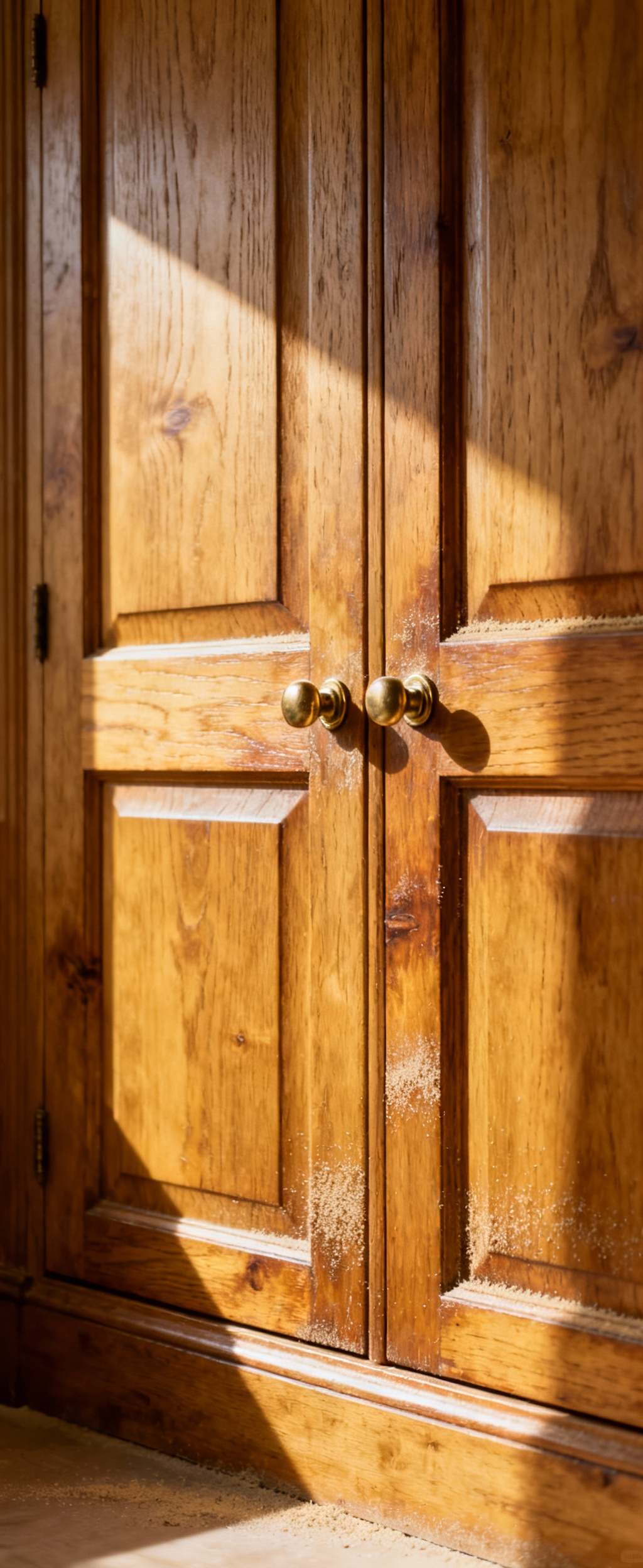
4. Adhering to Proportional Sovereignty: Mastering the Classical Rules of Cabinetry Dimensions
Beyond the character of the materials, the visual harmony of farmhouse kitchens cabinets depends entirely on good proportions. It’s an almost invisible art, but you feel it when it’s right—and you definitely notice when it’s wrong. This isn’t about blindly copying old designs; it’s about understanding the timeless visual relationships that make cabinetry feel balanced and substantial.
Classicism here simply refers to the scaling of doors, drawers, and the surrounding frame (the stiles and rails) relative to each other. If the stiles are too wide, the cabinet looks clunky. Too thin, and it feels cheap and weak. There are age-old principles, like the Golden Ratio, that often guide these decisions, creating a sense of visual ease. Even tiny details matter: the gap between doors, the projection of the countertop, the gentle taper of a cabinet leg. Years of professional experience taught me that getting these proportions right is what elevates simple cabinetry into something truly architectural and timeless.
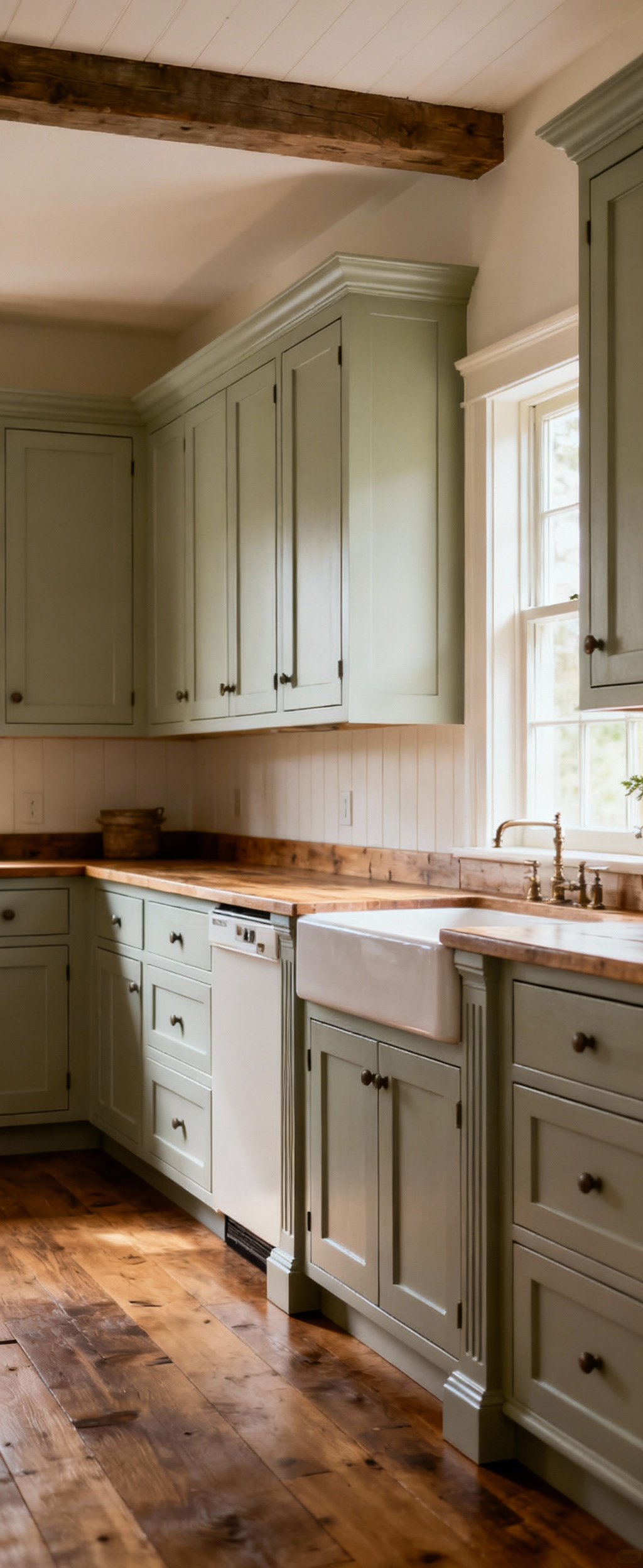
Foundational Principles: Unearthing the Vernacular Pedigree (Part 2)
Now that we’ve covered the basics of history and form, we have to talk about how to tell the real deal from a cheap knock-off. This is about training your eye to see beyond the surface and spot the core principles that make a design last, so you can avoid the fleeting trends that will look dated in five years.
5. Discerning Authenticity: Avoiding Superficial Replication and Trend-Driven Deviations
Achieving authentic farmhouse kitchens cabinets is so much more than just mimicking a rustic look. Honestly, the biggest mistake I see is what I call “theme park” farmhouse design—applying trends without any understanding of where they came from. Real authenticity isn’t about freezing a kitchen in 1890; it’s about channeling the philosophies that have made this style endure: honest materials, practical function, and a complete disregard for passing fads.
This thinking transforms when applied to your material choices. An authentic cabinet doesn’t have a fake distressed finish applied with a sander. Its character comes from real wood—like oak, pine, or maple—chosen for its toughness, with marks that tell a genuine story. Hardware is never just decorative; it’s solid and heavy, made from cast iron or unlacquered brass, because it was made to do a job. It has to feel right in your hand. Spatially, real farmhouse kitchens often feel unfitted, as if pieces were added over time, because they were. This creates a room that feels like it belongs to the house, not something dropped in from a showroom. Ultimately, this approach creates a kitchen that welcomes hard work and acquires a real patina from a life well-lived.
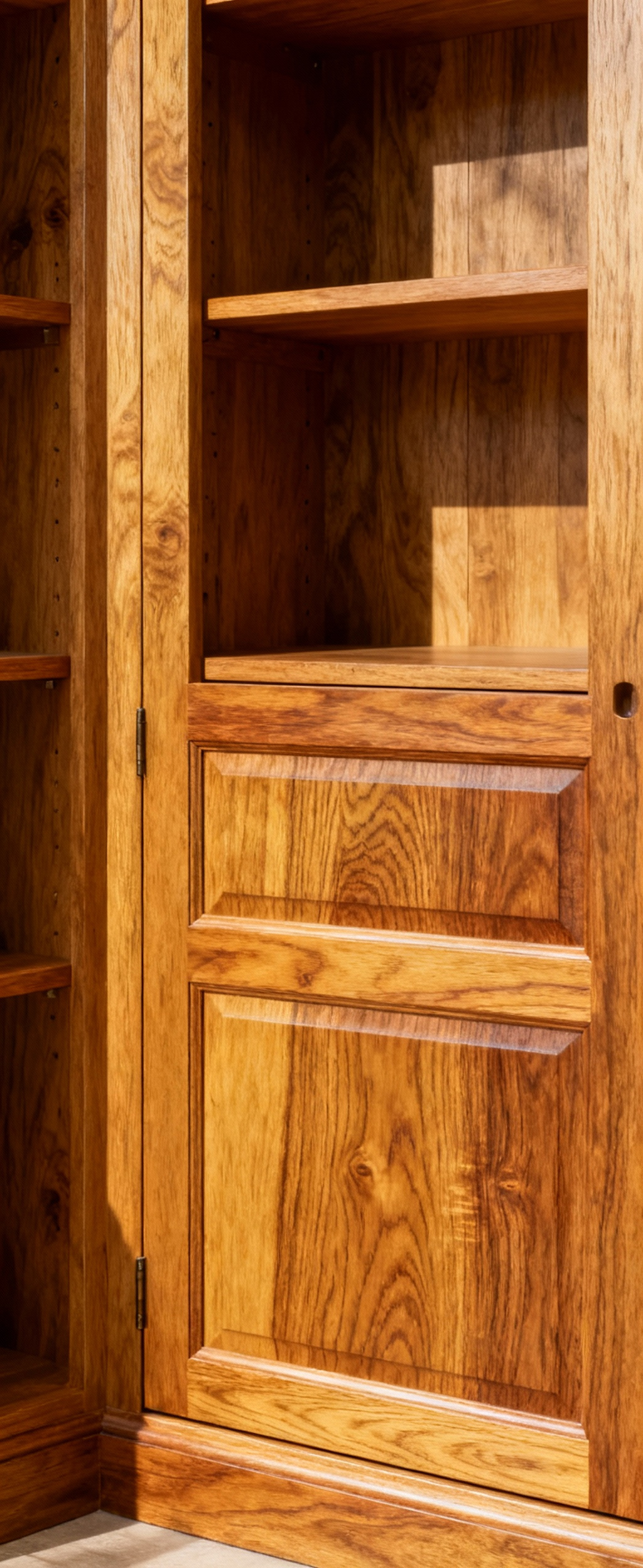
Material Exploration: Crafting Enduring Forms with Integrity (Part 1)
The soul of any great farmhouse kitchen starts with the materials. This isn’t just about looks; it’s about integrity. We’re going to get into the specific choices—from the wood to the finish to the hardware—that turn a simple cabinet into something that will last for generations.
6. Specifying Indigenous Hardwoods: Selecting Species for Optimal Durability and Aesthetic Resonance
The entire foundation of an authentic farmhouse kitchen rests on choosing the right wood. Forget about mass-produced composites; we’re talking about solid, indigenous hardwoods, selected for their strength and character. White oak is a classic for a reason. It’s incredibly hard, resists moisture, and has a beautiful open grain that just gets better with age. Maple is another great choice, offering a smoother, calmer grain that takes paint beautifully if you’re going that route.
For a warmer, richer feel, you can’t beat black cherry or walnut. Cherry deepens to an incredible reddish-brown over time, and walnut has that deep chocolate tone that feels both rustic and refined. Each wood has its own personality and its own story. The key is to choose a species not just for how it looks today, but for how it will perform and age over the next fifty years. This decision is the cornerstone of building farmhouse kitchens cabinets that are meant to become part of the house itself.
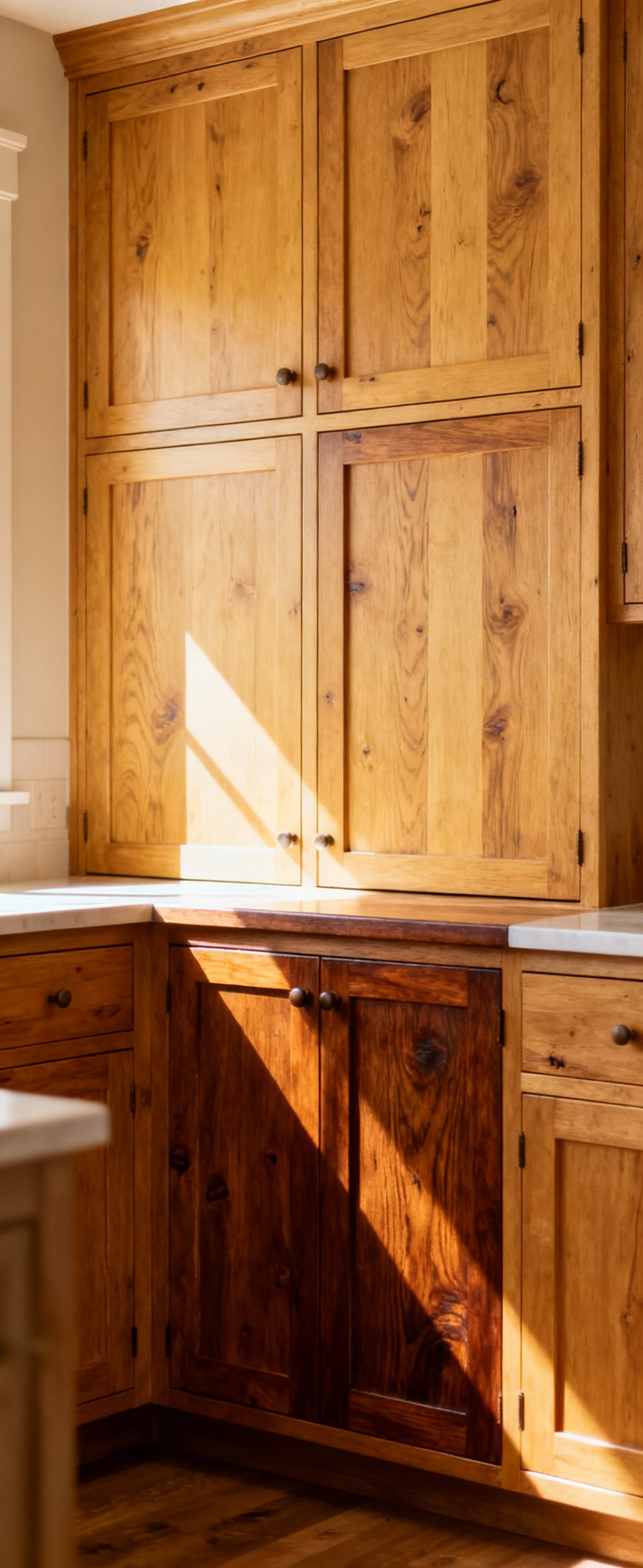
7. Mastering Traditional Joinery: The Indispensable Role of Mortise-and-Tenon for Structural Longevity
Once you have the right wood, how you put it together is what separates good from great. When I’m assessing historic millwork, the first thing I look at is the joinery. For heirloom-quality farmhouse kitchens cabinets, the mortise-and-tenon joint is the undisputed champion. This is a centuries-old technique where a tenon (a tab) on one piece of wood fits perfectly into a mortise (a hole) in another. It’s an interlocking connection that’s vastly superior to just using screws or nails.
What really gets me is seeing new “farmhouse” cabinets held together with staples. That’s not building; that’s just assembling. A mortise-and-tenon joint creates a mechanical bond within the wood itself. It means your cabinet doors won’t sag, and your face frames won’t rack or pull apart over time. This method ensures that the structure maintains its integrity, its crisp lines, and its smooth function, decade after decade. It’s the kind of hidden quality that you can feel every time you open a door.
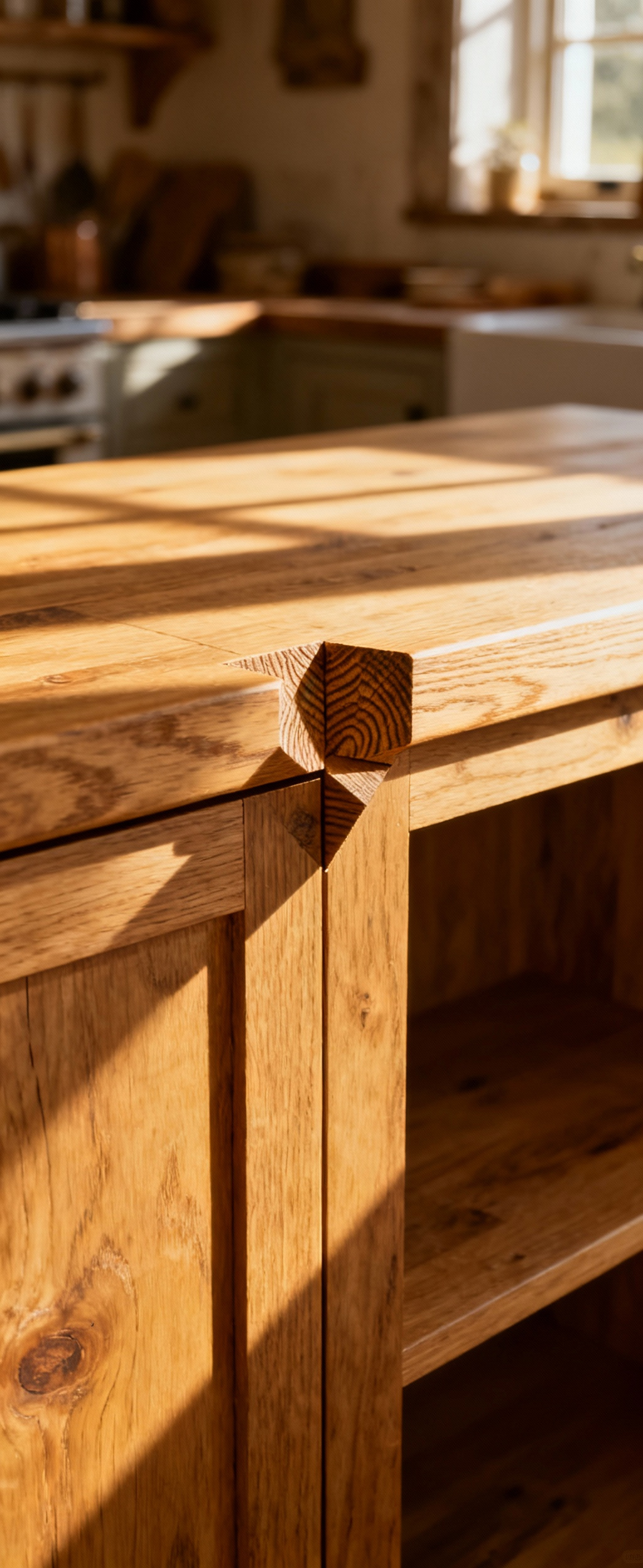
8. The Art of Hand-Applied Finishes: Achieving Depth, Texture, and Durability in Surface Treatments
The way a cabinet is finished is just as important as its construction. The goal here isn’t to create a perfect, plastic-like shell, but to protect and enhance the wood in a way that allows its character to show through. Hand-applied finishes are simply unmatched in their ability to create depth and a tactile quality that a spray gun never can. They let the wood breathe.
Consider a classic oil-and-wax finish. It sinks into the wood, nourishing it from within and creating a warm, satin luster that you just want to touch. Milk paint is another fantastic, historically accurate choice. It has a unique, chalky-matte look that ages beautifully, chipping and softening over time in a completely natural way. A proper painted finish should be layered, creating a subtle depth that hints at history rather than screaming “I was just distressed!” This hands-on approach builds a living finish that gets better with time.
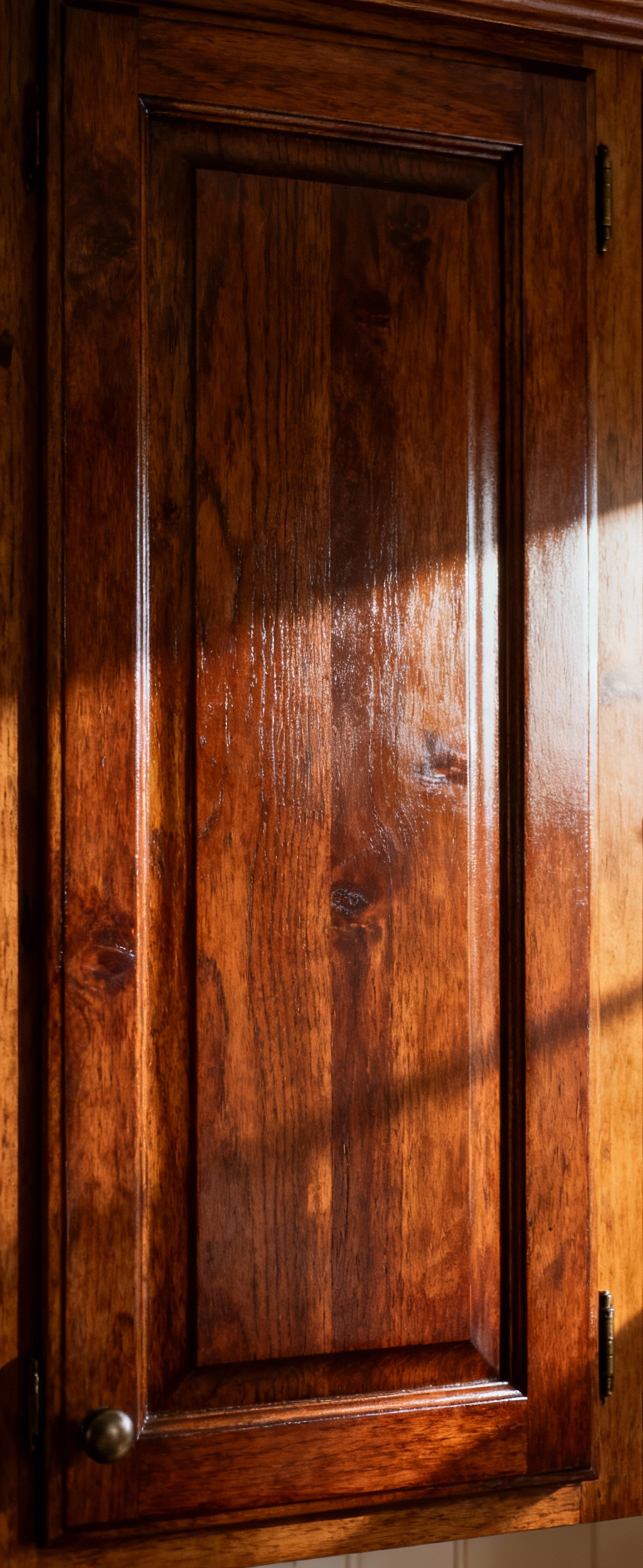
9. Curating Period-Appropriate Hardware: Elevating Function to the Realm of Bespoke Craftsmanship
The hardware is the jewelry of the kitchen. It’s a huge opportunity to get the period details right, but it’s also where a lot of projects go wrong. Choosing period-appropriate hardware for farmhouse kitchens cabinets is about more than just style; it’s about feel and function. Every knob, pull, and hinge should feel substantial and true to an era when things were built to last.
Materials like cast iron or forged steel have a satisfying heft and a natural patina that works perfectly with painted or rustic wood. Aged brass adds a touch of warmth and elegance without feeling fussy. And you can never go wrong with simple black or white porcelain knobs for a clean, classic look. I’ve noticed that people often overlook the style of the hinge, but exposed strap hinges or classic butt hinges can make a huge difference in the overall authenticity. Selecting the right hardware is the final touch that ties the whole story together, making the cabinets feel rooted and real.
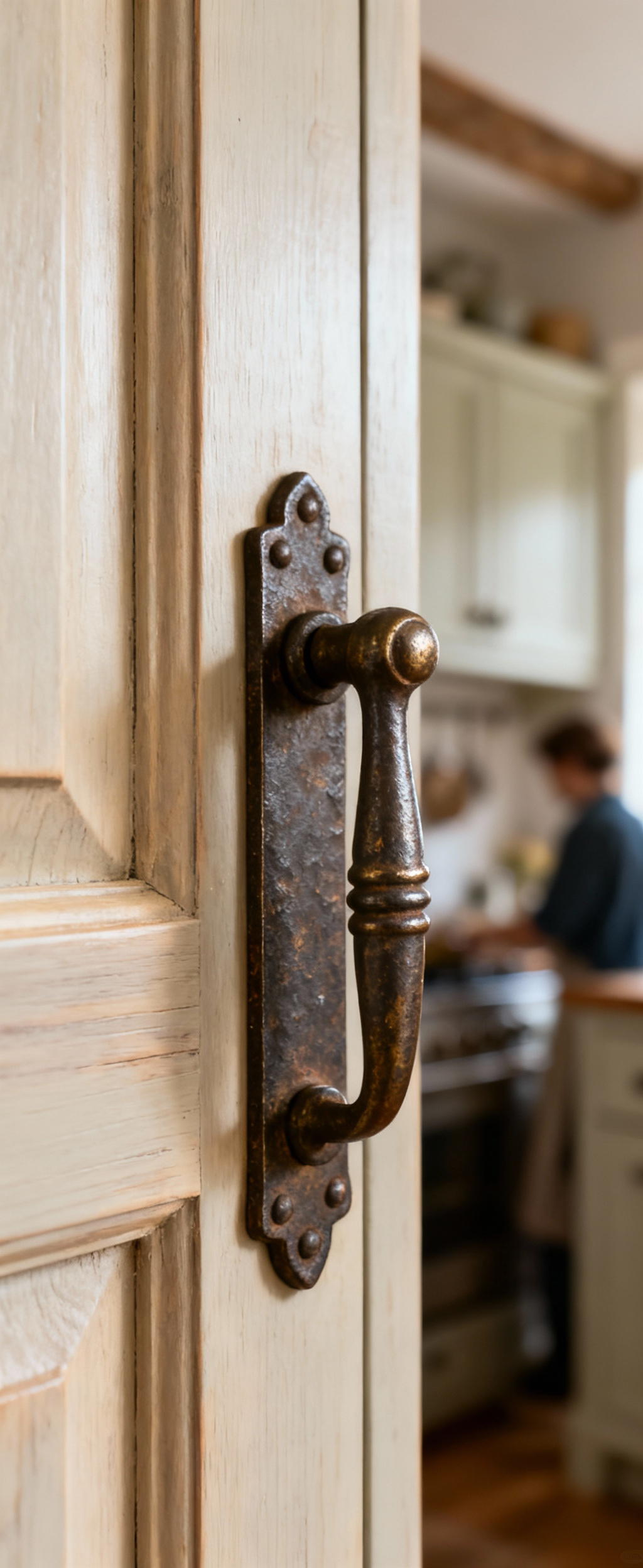
Material Exploration: Crafting Enduring Forms with Integrity (Part 2)
Diving deeper into the world of materials, we now turn to a construction method that is a true hallmark of fine craftsmanship. This isn’t something you’ll find in a big-box store, but understanding it is key to recognizing and commissioning cabinetry that is truly built to endure for a century or more.
10. Understanding Full Inset Door Construction: The Benchmark for Precision and Timeless Elegance
If you want the gold standard for authentic farmhouse kitchens cabinets, look no further than full inset construction. This is a time-honored technique where the cabinet door sits perfectly flush inside the face frame, rather than sitting on top of it like most modern cabinets do. It demands incredible precision from the cabinetmaker, because any tiny imperfection in the fit is immediately obvious. The clean, consistent gap—or “reveal”—around the door is a signature of this style.
From my work in period-appropriate renovation, I can tell you that inset cabinetry is a hallmark of high-quality, pre-war homes. It creates a beautiful, clean plane that feels solid and architectural. The hinges, typically traditional barrel hinges, are mortised into the wood, making for an incredibly strong and stable door that won’t sag. While it’s a more labor-intensive and expensive option, the payoff is immense. You get a piece of furniture-grade cabinetry that has an unmistakable look and feel of quality and permanence. It’s not just a design choice; it’s a statement about your commitment to craftsmanship.
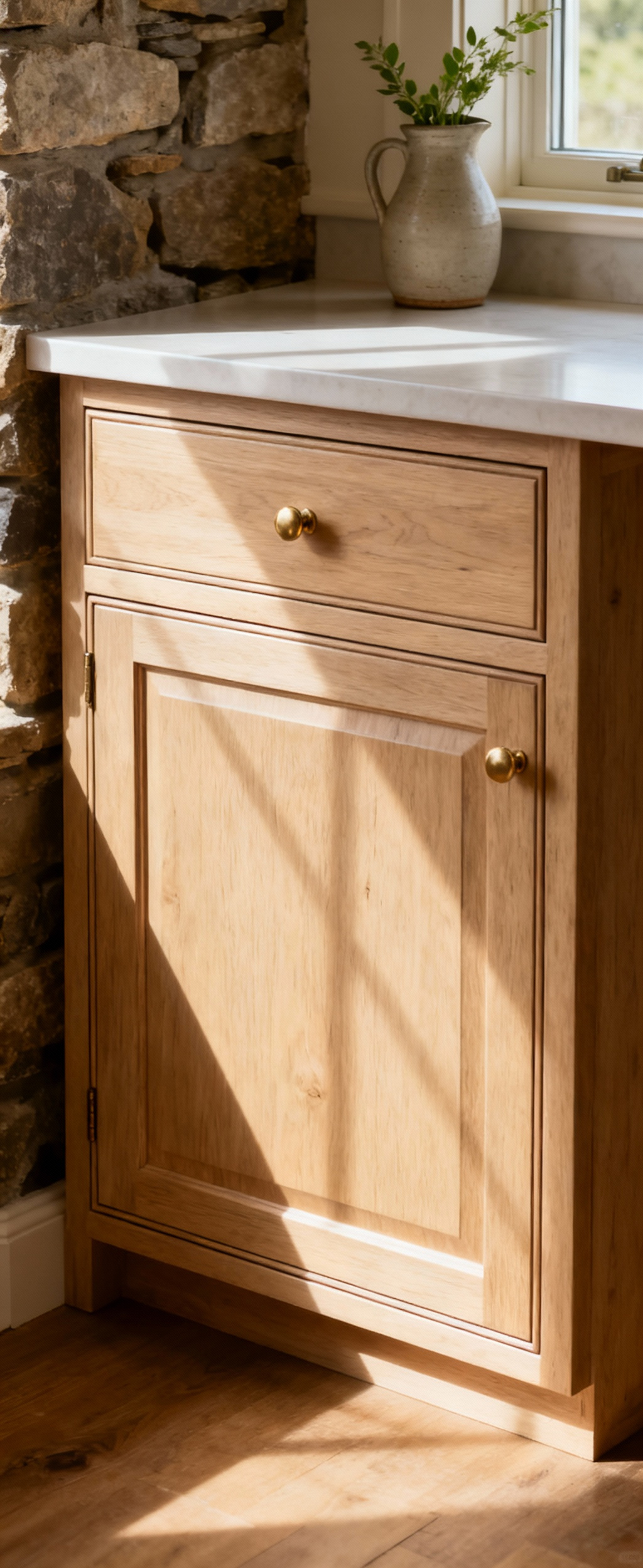
Spatial Application: Harmonizing Cabinetry with Culinary Dynamics (Part 1)
Now we move from the object to the space. It doesn’t matter how beautifully a cabinet is made if it’s in the wrong place. This is about how we arrange our farmhouse kitchens cabinets to create a kitchen that not only looks right but works right, harmonizing those old-world aesthetics with the way we actually cook and live today.
11. Optimizing Ergonomic Flow: Strategic Configuration of Task-Centric Cabinetry Zones
A great farmhouse kitchen just flows. It feels intuitive. That’s not an accident; it’s the result of carefully planned ergonomics. We need to think beyond the old “work triangle” and create dedicated zones for different tasks: a prep zone, a cooking zone, and a cleanup zone. The cabinetry in each zone should be tailored to support that specific activity.
Your prep zone should have easy access to knives, cutting boards, and compost bins. The cooking zone needs pull-outs for spices and drawers for pots and pans right next to the range. And the cleanup zone should have the dishwasher, trash, and sink all working together. The island often serves as the critical bridge between these zones. I learned this when restoring a large 1920s kitchen: by creating these task-centric hubs, we allowed multiple people to work together without constantly bumping into each other. It’s about making the kitchen an effortless extension of the cook.
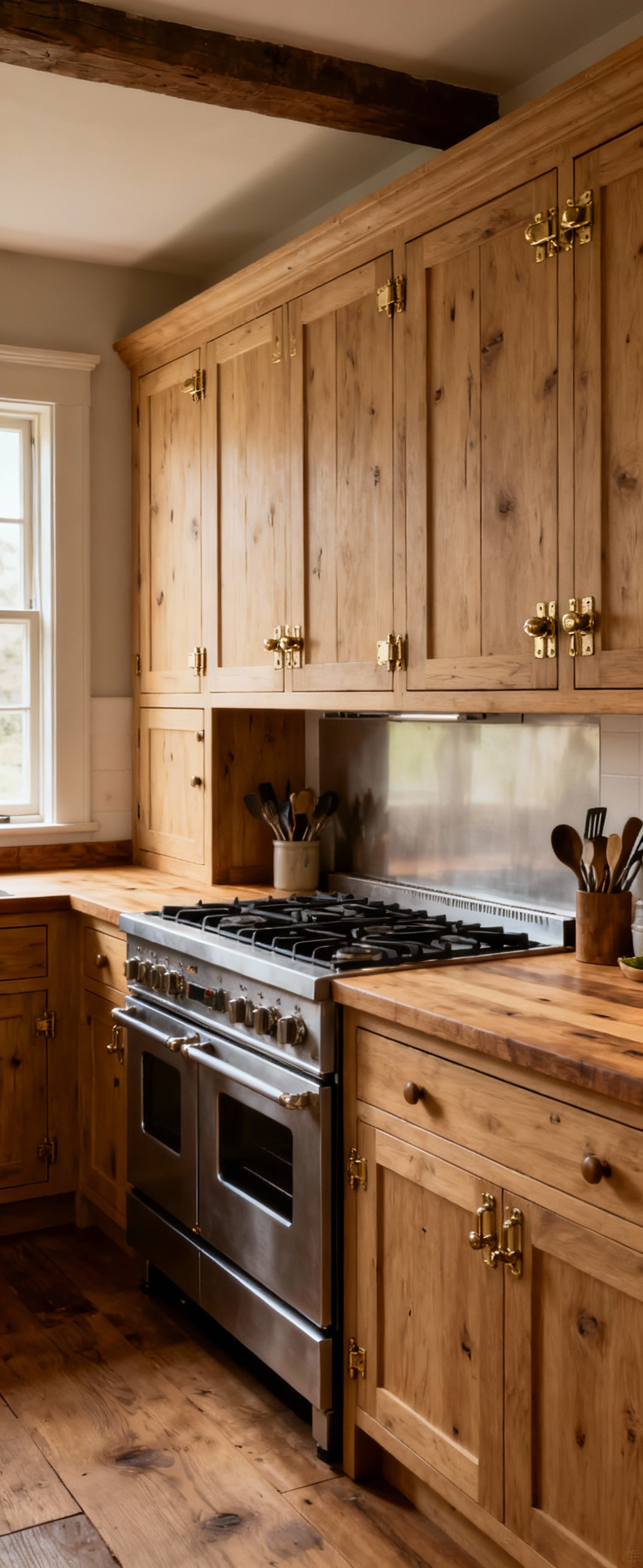
12. Discreet Appliance Integration: Concealing Modern Conveniences Within Period-Appropriate Facades
Here’s the big challenge in any historic kitchen renovation: what do you do with the refrigerator? The goal is to integrate modern appliances so seamlessly that they don’t disrupt the historical character of the space. It’s about hiding technology in plain sight.
The best way to do this is with custom cabinet panels. A paneled refrigerator and dishwasher can disappear completely into a run of farmhouse kitchens cabinets, allowing the eye to focus on the craftsmanship. Microwaves can be hidden in a pantry or placed in a drawer-style unit in the island. I’ve even designed custom wood surrounds for range hoods that make them look like traditional mantelpieces. The idea is to let the beautiful materials and authentic details be the star of the show, not the stainless steel. It proves you don’t have to sacrifice modern convenience to achieve a timeless look.
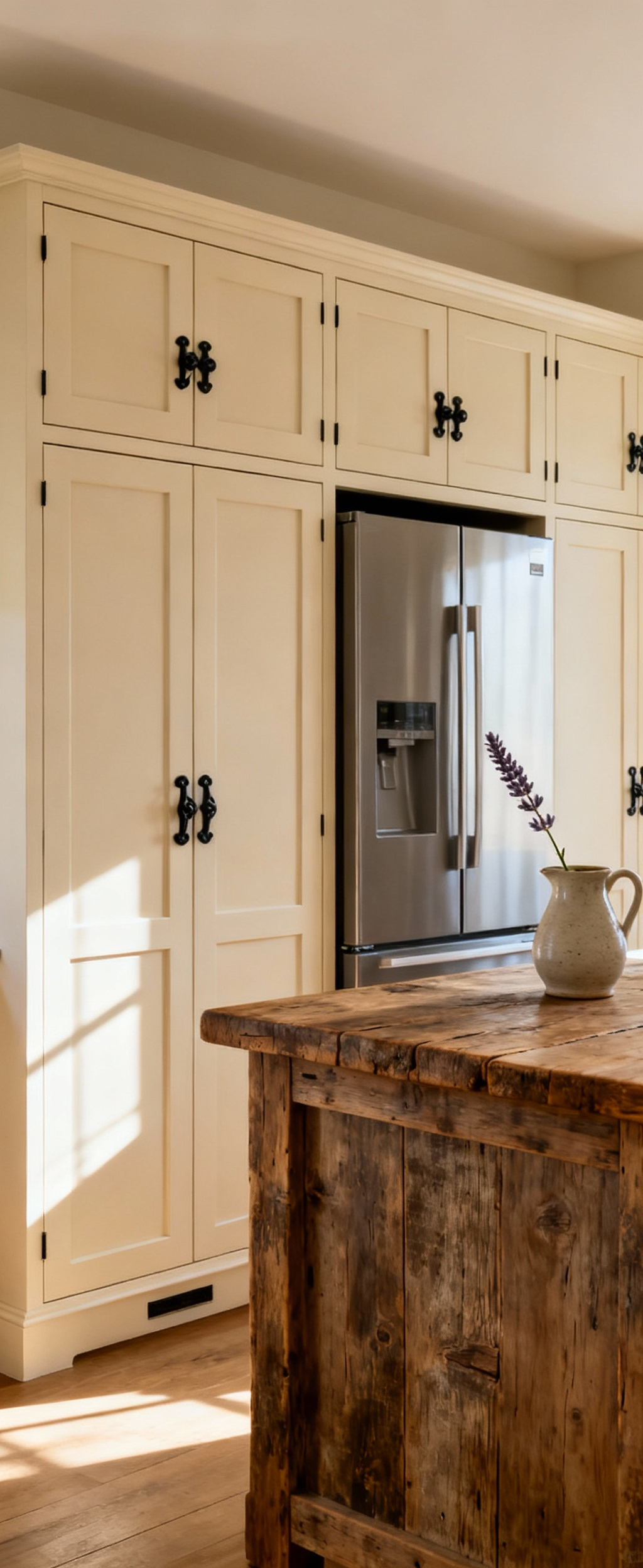
13. Bespoke Cabinetry for Architectural Specifics: Addressing Irregularities with Custom Elegance
Older homes are rarely perfect. They have sloping floors, crooked walls, and weird niches. This is where bespoke, custom-built cabinetry isn’t a luxury—it’s a necessity. Trying to force stock cabinets into a historic space almost never works. Instead of fighting those quirks, a custom approach allows you to celebrate them.
A skilled cabinetmaker can scribe a cabinet perfectly to a wavy plaster wall, build shallow storage into a tight space, or create a beautiful built-in that frames an old window perfectly. In my historic home renovation specialist practice, we see these architectural irregularities as opportunities. They allow us to create a kitchen that feels completely organic to the house, as if it has always been there. This meticulous tailoring is what makes the kitchen feel like a truly integrated part of the home’s soul, not just a room filled with boxes.
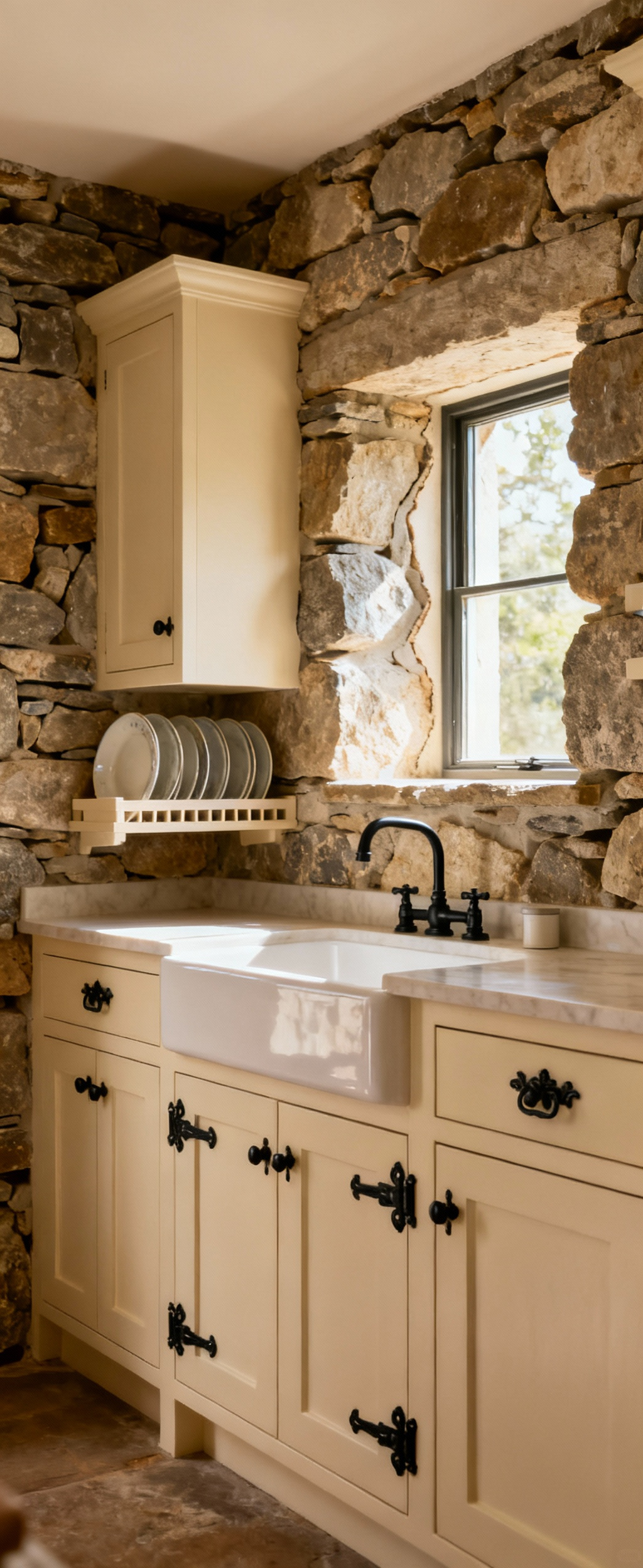
14. Maximizing Storage Efficacy: Thoughtful Inclusion of Specialized Interior Solutions
The exterior of your farmhouse kitchens cabinets might look a hundred years old, but the interiors can be packed with modern ingenuity. True mastery of the form lies in creating storage that is incredibly efficient without compromising the aesthetic. This is about making every square inch work for you.
Think about custom drawer dividers for utensils, so you’re not digging through a junk drawer. Install vertical storage for baking sheets and cutting boards. Use clever pull-out systems for blind corners so that space doesn’t become a black hole. We can even build in dedicated appliance garages or hidden charging stations. The goal is to maintain a serene, uncluttered look on the outside by being incredibly organized on the inside. This thoughtful approach to interior solutions is what makes a beautiful kitchen truly livable.
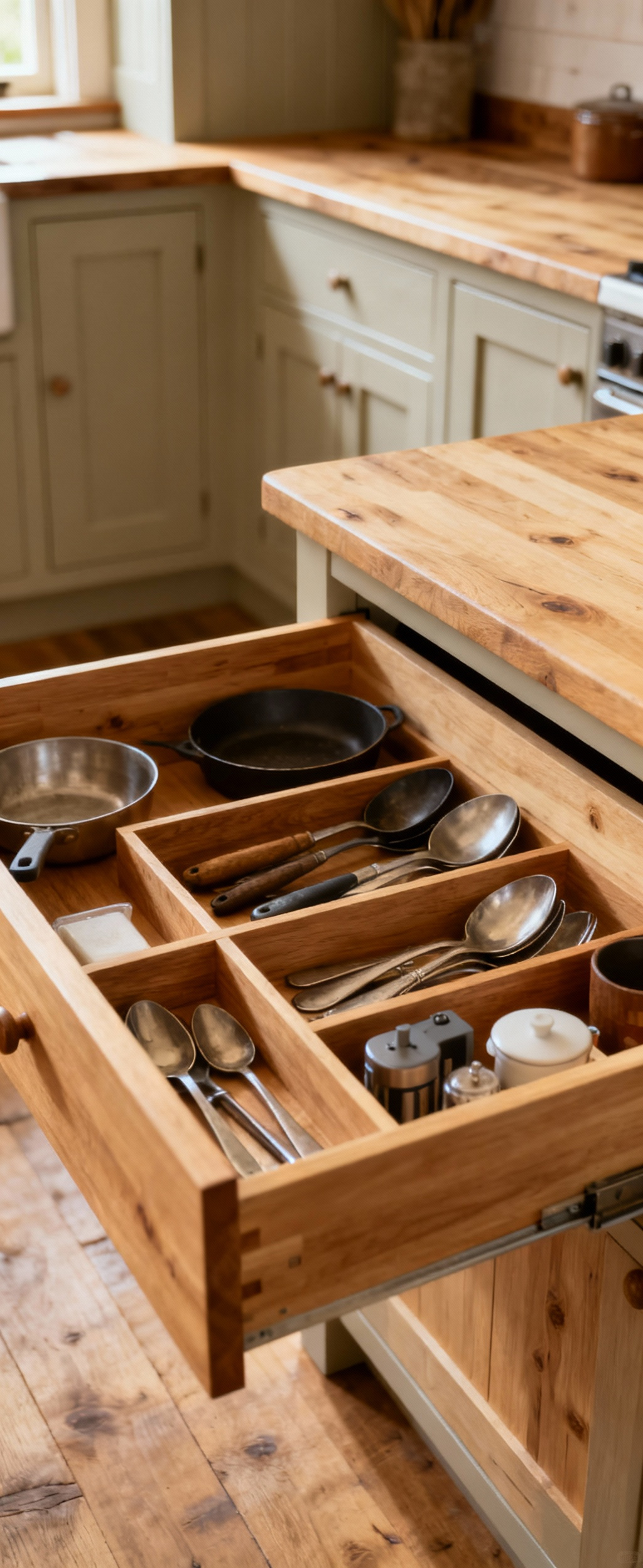
Spatial Application: Harmonizing Cabinetry with Culinary Dynamics (Part 2)
As we refine our understanding of spatial layout, we must consider an approach that is fundamental to the authentic farmhouse look: moving away from rigid, wall-to-wall installations. Embracing individual, furniture-like pieces is key to creating a kitchen that feels collected and curated over time, rather than installed all at once.
15. The Unfitted Aesthetic: Incorporating Stand-Alone Pieces for Organic Composition and Versatility
One of the most effective ways to achieve an authentic look is to embrace the “unfitted” kitchen. Historically, kitchens were furnished with individual pieces—a worktable here, a hutch there. This creates a much more organic and versatile space than a solid wall of identical built-in cabinets. It gives the room character, texture, and a sense of having evolved over time.
I often encourage clients to think about a large, freestanding worktable instead of a permanent island. It can be moved or replaced, and it feels more like a piece of heritage furniture. An antique sideboard or dresser can provide wonderful storage and a beautiful focal point. The trick is to keep a common thread running through the pieces—perhaps a consistent wood tone, paint color, or hardware style—to create a cohesive look without being monotonous. Using an unfitted approach for your farmhouse kitchens cabinets instantly injects a layer of history and soul that built-ins can sometimes lack.
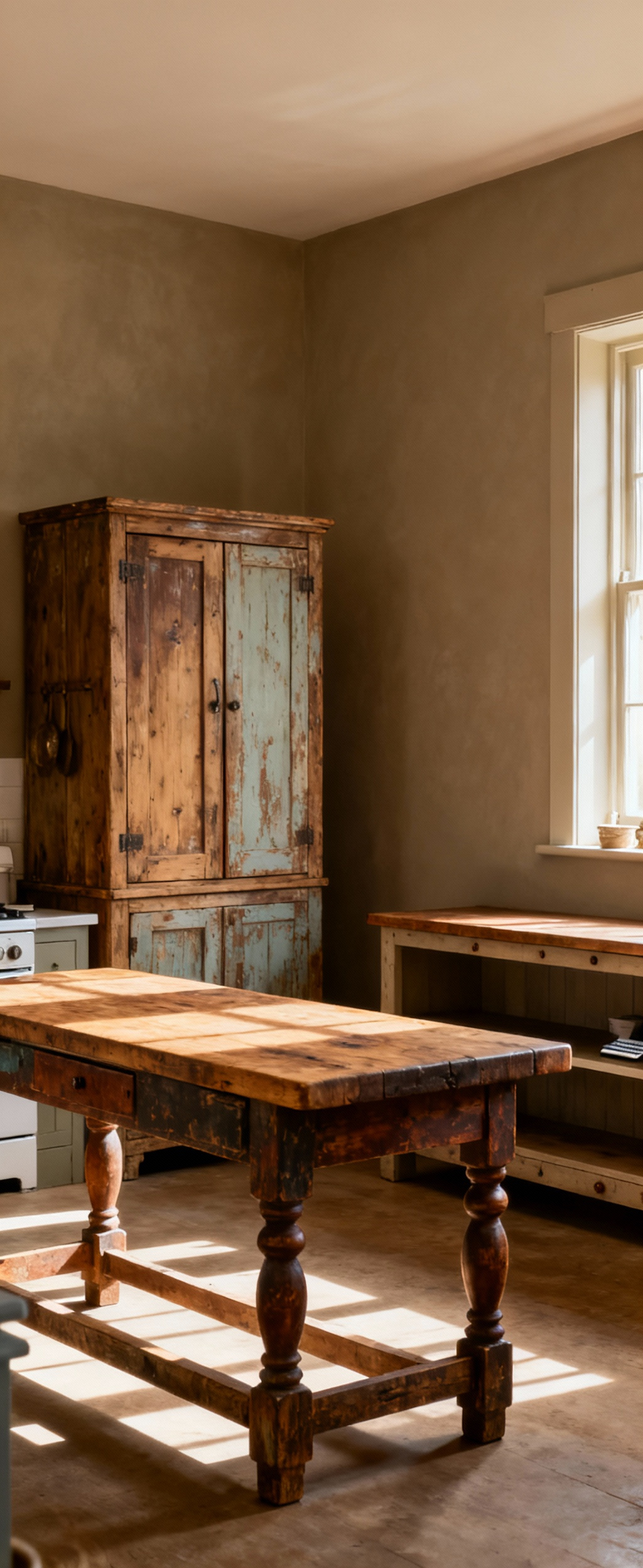
Lifestyle Integration: Sustaining Legacy and Evolving Utility (Part 1)
The best cabinetry does more than just hold your dishes. It becomes part of the rhythm of your life, designed to endure and adapt across generations. This final section is about the philosophy of living with your kitchen—how to ensure it lasts, ages beautifully, and remains relevant for years to come.
16. Ensuring Intergenerational Durability: Prioritizing Robustness Over Planned Obsolescence
The whole philosophy behind this style stands in direct opposition to today’s throwaway culture. When we talk about farmhouse kitchens cabinets, we’re talking about building something permanent. It’s a commitment to creating a piece of the house that will serve not just you, but your children and grandchildren. This is about making a long-term investment in quality that bypasses the wasteful cycle of trends.
This starts with solid hardwoods—not particleboard—that can withstand decades of use. It continues with traditional joinery, like dovetails and mortise-and-tenons, that provides a level of structural integrity you can’t get from staples and glue. Even the hardware, the drawer slides and hinges, should be heavy-duty and built to last a lifetime. What I tell my clients is this: your cabinetry should become an immovable, dependable fixture in the home, accruing character and stories, not just wearing out. It becomes an anchor in the home’s intergenerational story.
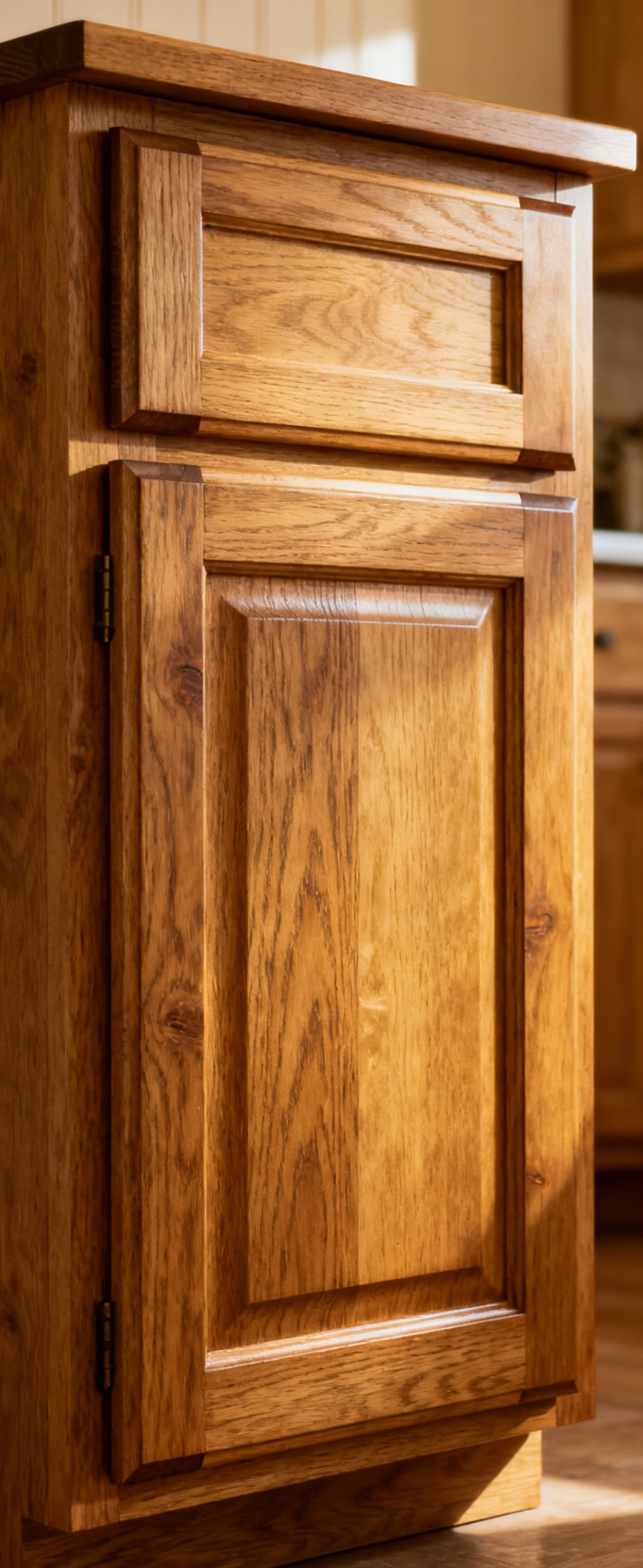
17. Cultivating a Gracefully Worn Aesthetic: Strategies for Harmonious Ageing and Maintenance
Once you’ve built for durability, you have to embrace the way things age. I’m not talking about fake distressing; I’m talking about a real, honest patina that develops over years of use. It’s the soft shine on a drawer pull from thousands of openings, the slight darkening of the wood near a window. These are not flaws; they are the signs of a life well-lived.
This starts with choosing the right finishes. Natural oils, waxes, and milk paints are great because they aren’t impervious shields. They allow the wood to breathe and evolve, and more importantly, they are repairable. A small scratch can be buffed out or re-oiled, integrating the mark into the cabinet’s story rather than creating an eyesore. This mindset transforms maintenance from a chore into a form of stewardship. You are caring for a piece of your home’s history and contributing to its evolving beauty.
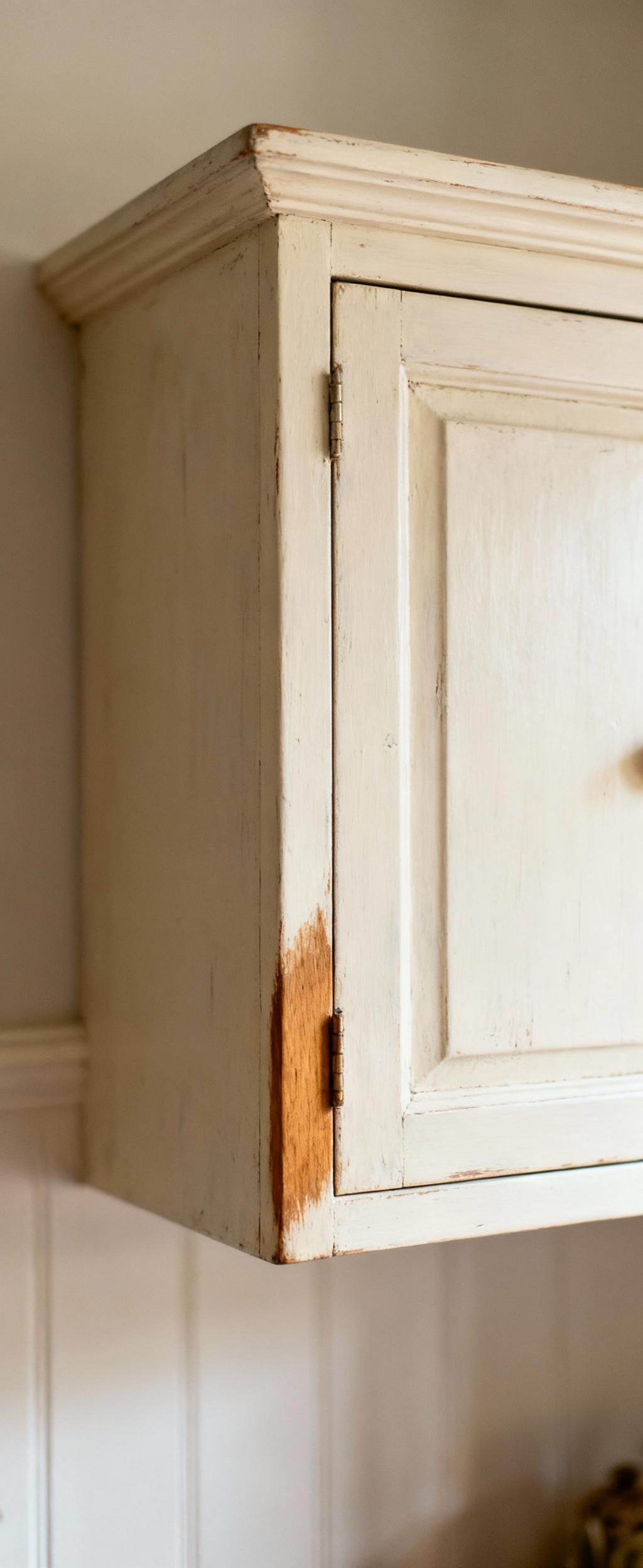
18. Implementing Sustainable Sourcing: Responsible Material Selection for Environmental Stewardship
The traditional farmhouse ethos was inherently sustainable—you used what was local and wasted nothing. We should bring that same sense of stewardship to our modern projects. This means thinking about where our materials come from and what impact they have on the environment. It’s about ensuring the legacy of our kitchen extends beyond the four walls of our home.
Reclaimed wood is a fantastic option, bringing instant history and character to new cabinetry while keeping valuable materials out of the landfill. If you’re using new wood, look for FSC-certified timber to ensure it comes from responsibly managed forests. Using local species also reduces the carbon footprint from transportation. The same goes for finishes—choose low-VOC or natural options to keep your indoor air healthy. Knowing your farmhouse kitchens cabinets are built from materials that honor our natural resources adds another layer of integrity and meaning to your project.
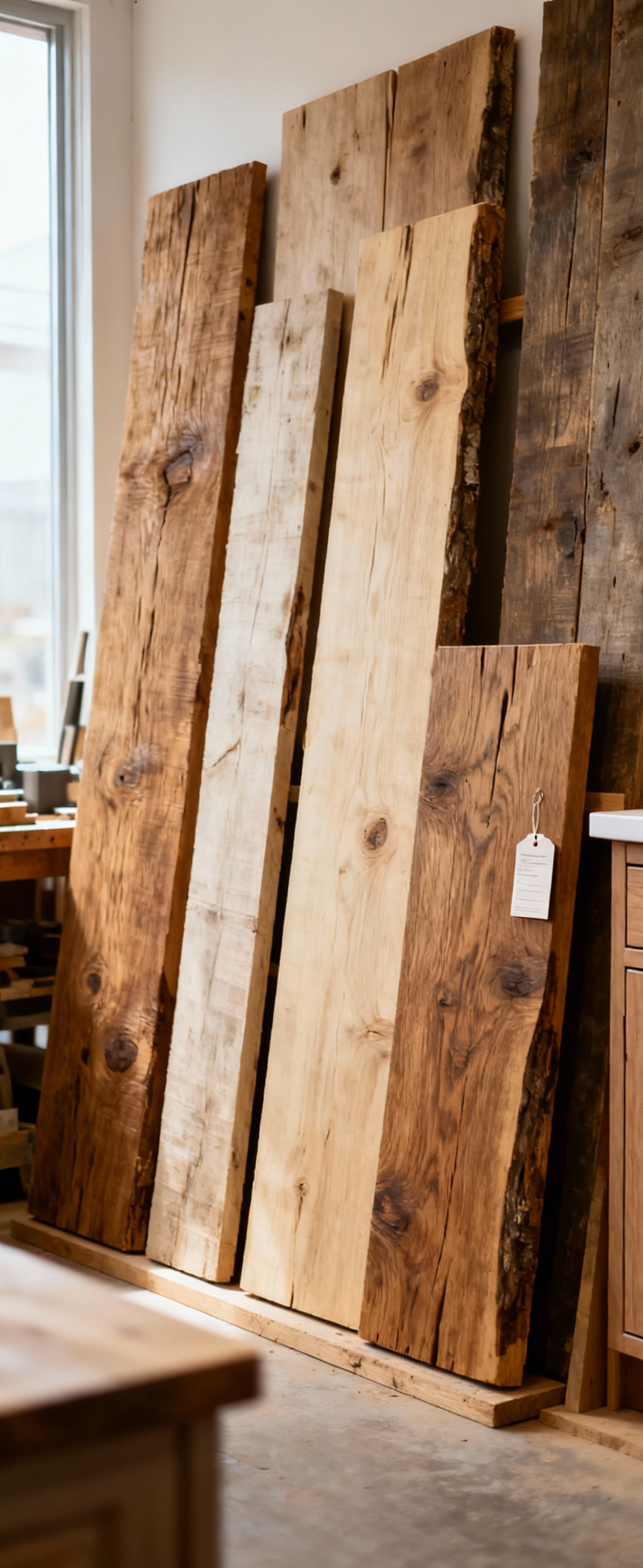
19. Designing for Future Evolvability: Crafting Adaptable Cabinetry Without Sacrificing Character
The final test of great design is its ability to adapt. A truly enduring kitchen should be able to evolve with your family’s needs without requiring a full demolition. This means designing for flexibility within a timeless framework. The outside can look classic and permanent, while the inside is modular and adaptable.
Think about adjustable shelves that can change as your storage needs do. Design deep drawers with removable dividers. I often suggest designing a cabinet run with a space that could one day hold a wine fridge or a second dishwasher, with the wiring roughed in behind the wall. This kind of foresight ensures that your kitchen remains functional and relevant for decades. It extends the life of your investment and ensures your beautiful farmhouse kitchens cabinets continue to serve your family well, no matter how life changes.
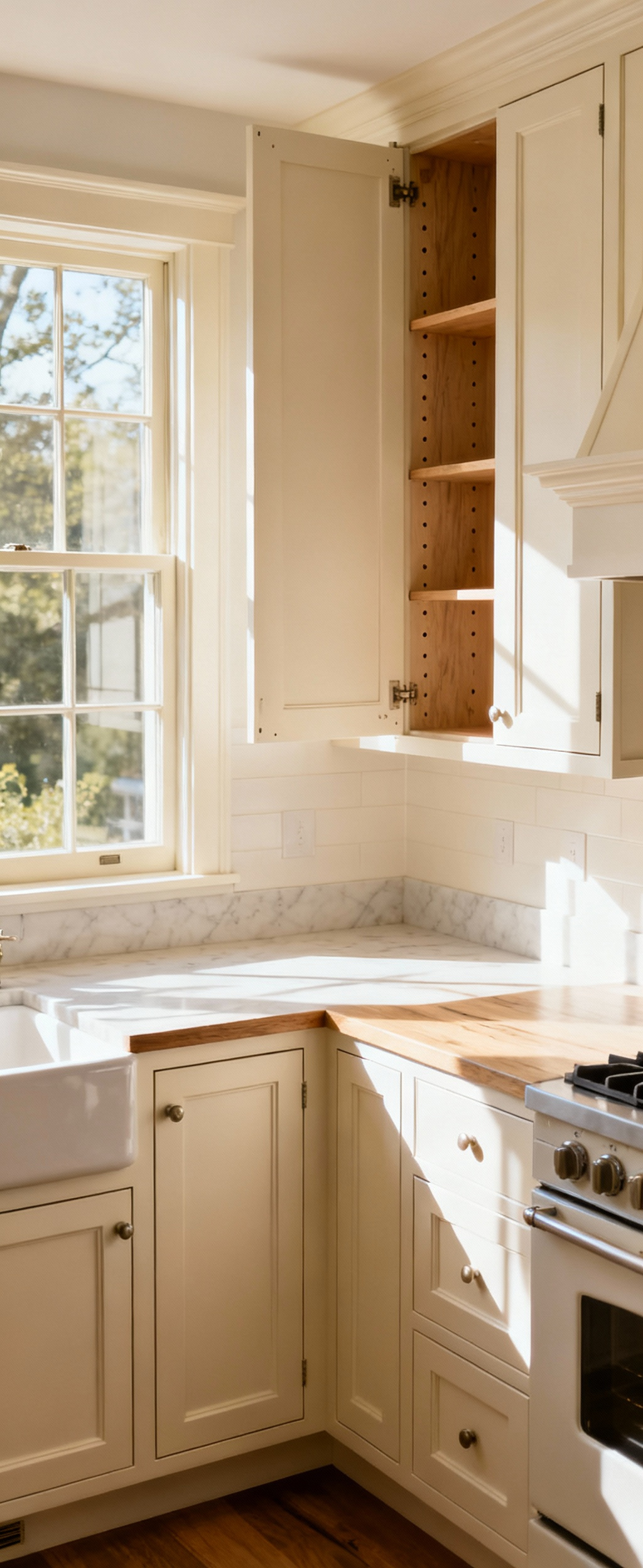
Lifestyle Integration: Sustaining Legacy and Evolving Utility (Part 2)
Building on these core principles, we arrive at the heart of the matter: how this style of cabinetry integrates into the fabric of daily life. It’s more than a design choice; it’s an embrace of quality and artisanship that shapes the very experience of being in your home, turning the kitchen into a place of connection, history, and enduring value.
20. Embracing Legacy Craftsmanship: Recognizing the Intrinsic Value of Enduring Artisanal Quality
Ultimately, choosing authentic farmhouse kitchens cabinets is an embrace of legacy craftsmanship. In an age of fast furniture and disposable goods, it’s a powerful statement to invest in something made with human skill and a commitment to permanence. This is the intrinsic value that can’t be replicated by a machine. It’s the soul of the kitchen.
You can feel this quality every single day. It’s in the solid, satisfying thud of a well-made door closing. It’s in the feel of a hand-planed surface or the visual depth of a finish that has been rubbed in with care. These are the details that elevate a kitchen from a purely functional space to one that provides genuine pleasure and a sense of grounding. In my professional experience, I’ve seen that living with objects that possess this kind of artisanal soul enriches daily life. It fosters a connection to the past and a legacy for the future, reminding us that true luxury isn’t about what’s new, but about what lasts.
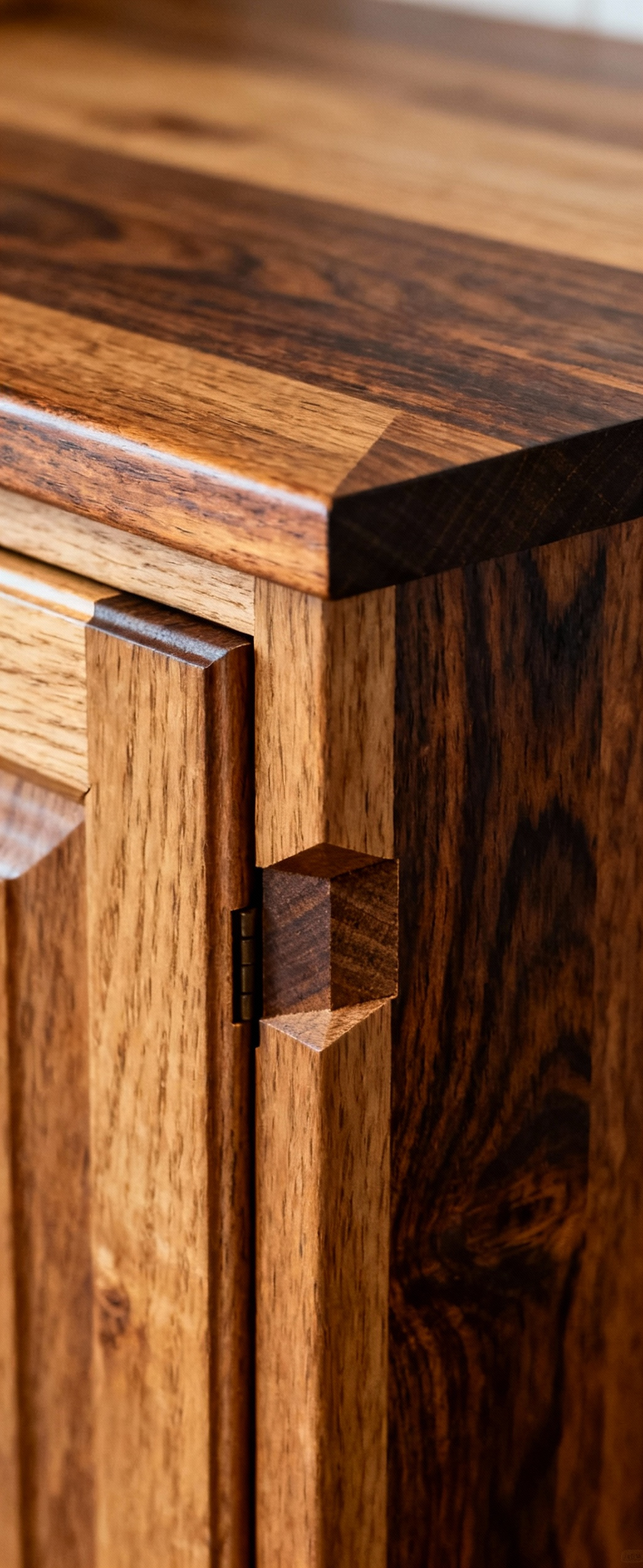
Conclusion
As we’ve walked through these twenty principles, it’s clear that authentic farmhouse design is about so much more than a look. It’s a philosophy. We’ve gone beyond the surface to understand that the enduring appeal of farmhouse kitchens cabinets comes from their deep roots in history, their commitment to honest materials, and their celebration of practical, beautiful craftsmanship. It’s not a trend to be copied, but a tradition to be understood and carried forward.
The goal here isn’t to create a museum piece, but a living, breathing kitchen that honors its heritage while serving your modern life. Think of these principles as your guide to making informed, meaningful choices—choices that will result in a kitchen that feels not just beautifully designed, but deeply right. When you invest in this level of quality and thought, your cabinets cease to be mere objects. They become the heart of your home, ready to serve your family and tell its story for generations to come.
